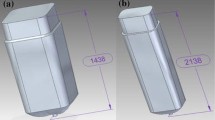Abstract
Periodic mould level fluctuation (MLF) during slab casting is a bottleneck for upgrading the surface quality and casting speed especially for hypoperitectic (HP) or ultralow carbon steels. The uneven growth of the initially solidified shell is verified to be one of the important inducements to MLF due to related unsteady bulging in the secondary cooling zone. It is shown that the solidification mode of steels and the contraction behavior can be modified through chemical composition optimization within given composition limits. For high strength low alloy (HSLA) steels, the actual peritectic points calculated by Thermo-Calc software may change remarkably with the slight variations of alloying element contents. Accordingly, the narrow limit of chemical composition of HP steels through optimization is proven to be one of the effective factors to control the popular MLF phenomenon during slab casting.
Similar content being viewed by others
Abbreviations
- C A :
-
Maximal carbon content of ultralow carbon steel, wt%
- C B :
-
Maximal solubility of carbon in high-temperature ferrite, wt%
- C C :
-
Carbon content on the peritectic point, wt%
- C D :
-
Minimal carbon content of high carbon steel, wt%
- C B-w[C] and C C-w[C]:
-
Peritectic characteristic point and actual carbon point, respectively
- T P :
-
Peritectic reaction temperature
- w[X]:
-
Element X content of actual steel, X=C, Al, Mn, Si, Ni, Mo, V, and Cr
References
J.D. Lee and C.H. Yim, The mechanism of unsteady bulging and its analysis with the finite element method for continuously cast steel, ISIJ Int., 40(2000), No. 8, p. 765.
T. Emi and H. Fredriksson, High-speed continuous casting of peritectic carbon steels, Mater. Sci. Eng., A, 413(2005), p. 2.
M. Suzuki and Y. Yamaoka, Influence of carbon content on solidifying shell growth of carbon steels at the initial stage of solidification, Mater. Trans., 44(2003), No. 5, p. 836.
K.E. Blazek, O. Lanzi, P.L. Gano, and D.L. Kellogg, Calculation of the peritectic range for steel alloys, Iron Steel Technol., 5(2008), No. 7, p. 80.
M.S. Jenkins, B.G. Thomas, and R.B. Mahapatra, Investigation of strand surface defects using mould instrumentation and modeling, Ironmaking Steelmaking, 31(2004), No. 6, p. 485.
C. Furtmueller and E. Gruenbacher, Suppression of periodic disturbances in continuous casting using an internal model predictor, [in] Proceedings of the 2006 IEEE International Conference on Control Applications, Munich, 2006, p. 1764.
S. Mazumdar and S.K. Ray, Solidification control in continuous casting of steel, Sadhana, 26(2001), p. 179.
H. Mizukami and A. Yamanaka, Generation mechanism of unevenness of ultra low carbon steel at initial stage of solidification, ISIJ Int., 50(2010), No. 3, p. 435.
Z.Q. Song, Q.Q. Chen, and Y.H. Zhang, Practice on mould level fluctuation control of vertical-bending type caster in refining peritectic steel, Steelmaking, 23(2007), No. 4, p. 7.
Author information
Authors and Affiliations
Corresponding author
Rights and permissions
About this article
Cite this article
Li, Y., Zhang, Xh., Lan, P. et al. Control of mould level fluctuation through the modification of steel composition. Int J Miner Metall Mater 20, 138–145 (2013). https://doi.org/10.1007/s12613-013-0705-8
Received:
Revised:
Accepted:
Published:
Issue Date:
DOI: https://doi.org/10.1007/s12613-013-0705-8




